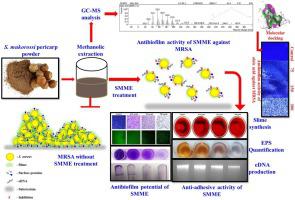Microbiological Research ( IF 6.1 ) Pub Date : 2020-09-25 , DOI: 10.1016/j.micres.2020.126601 Anthonymuthu Selvaraj 1 , Alaguvel Valliammai 1 , Muruganatham Premika 1 , Arumugam Priya 1 , James Prabhanand Bhaskar 2 , Venkateswaran Krishnan 2 , Shunmugiah Karutha Pandian 1

|
Plants are boon to the mankind due to plenty of metabolites with medicinal values. Though plants have traditionally been used to treat various diseases, their biological values are not completely explored yet. Sapindus mukorossi is one such ethnobotanical plant identified for various biological activities. As biofilm formation and biofilm mediated drug resistance of methicillin-resistant Staphylococcus aureus (MRSA) have raised as serious global issue, search for antibiofilm agents has gained greater importance. Notably, antibiofilm potential of S. mukorossi is still unexplored. The aim of the study is to explore the effect of S. mukorossi methanolic extract (SMME) on MRSA biofilm formation and adhesive molecules production. Significantly, SMME exhibited 82 % of biofilm inhibition at 250 μg/mL without affecting the growth and microscopic analyses evidenced the concentration dependent antibiofilm activity of SMME. In vitro assays exhibited the reduction in slime, cell surface hydrophobicity, autoaggregation, extracellular polysaccharides substance and extracellular DNA synthesis upon SMME treatment. Further, qPCR analysis confirmed the ability of SMME to interfere with the expression of adhesion genes associated with biofilm formation such as icaA, icaD, fnbA, fnbB, clfA, cna, and altA. GC–MS analysis and molecular docking study revealed that oleic acid is responsible for the antibiofilm activity. FT-IR analysis validated the presence of oleic acid in SMME. These results suggest that SMME can be used as a promising therapeutic agent against MRSA biofilm-associated infections.
中文翻译:

Sapindus mukorossi Gaertn。及其生物活性代谢产物油酸通过下调粘附基因表达来阻止耐甲氧西林金黄色葡萄球菌生物膜形成
由于大量具有药用价值的代谢产物,植物对人类大有裨益。尽管传统上已将植物用于治疗各种疾病,但尚未完全探究其生物学价值。Sapindus mukorossi是一种被鉴定用于各种生物活动的民族植物。随着耐甲氧西林金黄色葡萄球菌(MRSA)的生物膜形成和生物膜介导的耐药性作为严重的全球性问题提出,寻找抗生物膜剂的重要性日益提高。值得注意的是,抗生物膜电位S.患子仍是未知。该研究的目的是探讨沙门氏菌的作用。甲醇提取物(SMME)对MRSA生物膜的形成和粘附分子的产生。值得注意的是,SMME在250μg/ mL时显示出82%的生物膜抑制作用,而不会影响生长,显微镜分析表明SMME具有浓度依赖性的抗生物膜活性。体外测定显示,经SMME处理后,粘液,细胞表面疏水性,自动聚集,细胞外多糖物质和细胞外DNA合成减少。此外,qPCR分析证实了SMME能够干扰与生物膜形成相关的粘附基因的表达,例如icaA,icaD,fnbA,fnbB,clfA,cna和altA。GC-MS分析和分子对接研究表明,油酸是抗生物膜活性的原因。FT-IR分析验证了SMME中油酸的存在。这些结果表明,SMME可以用作抗MRSA生物膜相关感染的有前途的治疗剂。











































 京公网安备 11010802027423号
京公网安备 11010802027423号